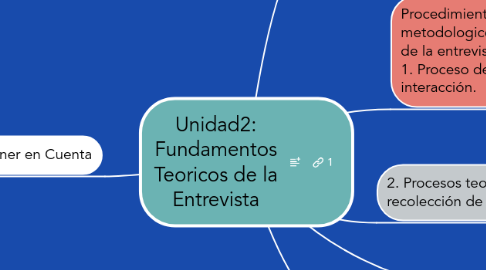
1. Para Tener en Cuenta
1.1. Tercero: Segun el nuemro de participantes(Individual, en panel, en grupo.
1.2. Segundo: Según la interacción de la interacción (Cara a cara, telefonica, Mediante tecnologías informáticas)
1.3. Primero: grado de regulación de la integración (estructura formal o en cuetionario, semiestructurada o sin cuestionario)
1.4. La entrevista es una tecnica de recolección de información y está clasificada así.
1.5. La entreviste permite tener información de diferentes contextos temporales.
1.6. La entrevista corresponde a un metodo de obtención de información, que utiliza las conversaciones como medio.
1.6.1. Training
1.6.2. Channels
1.6.3. International
1.6.4. Public Sector
1.6.5. Sales
1.6.6. Marketing Communications
1.6.7. Product Management
2. Fases tecnicas de la entrevista
2.1. Primero: Preparación y toma de contacto
2.2. Segundo: Cuerpo de la entrevista
2.3. Tercero: Cierre
3. Procedimientos metodologicos de la entrevista: 1. Proceso de interacción.
3.1. El entrevistado, es parte de la investigación
3.1.1. Situational Analysis / Drivers
3.1.1.1. What is driving us to do this?
3.1.1.2. SWOT Analysis
3.1.1.2.1. Strengths
3.1.1.2.2. Weaknesses
3.1.1.2.3. Opportunities
3.1.1.2.4. Threats
3.1.1.3. Customer Findings - What have we learned from customers?
3.1.2. Competitive Analysis
3.1.2.1. Do we have competitors and threats in these target markets with the proposed offerings?
3.1.2.2. What are our competitors doing and how are they positioning?
3.1.2.3. How do we position against each competitor?
3.1.3. Target Customer(s)
3.1.3.1. Buyer Profile
3.1.3.1.1. Title
3.1.3.1.2. Industry
3.1.3.1.3. Geography
3.1.3.1.4. Business Size
3.1.3.2. Influencer Profile
3.1.3.3. User Profile
3.1.3.4. What do customers want and need?
3.1.3.5. What business problems do each of these customers have?
3.1.4. Customer Segmentation
3.1.4.1. Which customers or sets of customers do we sell to?
3.1.4.2. What are the target market segments that we want to go after?
3.1.4.3. What are the distinct problems for each segment of the market?
3.1.5. Total Available Market
3.1.5.1. New Prospects
3.1.5.1.1. How much of each target segment have we penetrated?
3.1.5.1.2. How much opportunity is available in each target segment?
3.1.5.2. Existing Customers
3.1.5.2.1. Can we up-sell existing customers?
3.2. Cuando es una investigación cualitativa la selección de los entrevistados se basa en el potencial informativo
3.2.1. Service Offer
3.2.1.1. What are we selling?
3.2.1.2. Product Definition
3.2.1.3. Pricing
3.2.1.4. Packaging
3.2.1.5. Positioning
3.2.2. Value Proposition
3.2.2.1. What is the Value Proposition to the Customer?
3.2.2.2. What pain are we solving?
3.3. Teylor Bondag (1997): Plantea maneras de encontrar y selccionar a entrevsitar
3.3.1. Revenue Forecasts
3.3.1.1. Revenue and P&L Forecast (5 Years)
3.3.1.2. Revenue should be split out quarterly
3.3.2. Cost Analysis
3.3.2.1. Should include a description of the costs in entering this business and profitability analysis
3.3.3. Profitability Analysis
3.3.3.1. P&L for the offer to include gross margin, net income and break even analysis.
3.4. Las ideas erroneas se deben dejar en claro en la entrevista.
3.4.1. Sales Strategy
3.4.1.1. Direct Sales Strategy
3.4.1.2. Inside Sales Strategy
3.4.1.3. Channel Sales Strategy
3.4.2. Partner Strategy
3.4.2.1. Channel Strategy
3.4.2.1.1. What 3rd party channels should we consider for reselling this service?
3.4.2.2. Technology Partnerships
3.4.2.2.1. What technology vendors (if any) do we need to work with to execute on this plan?
3.4.2.3. Solutions Partners
